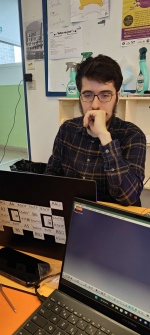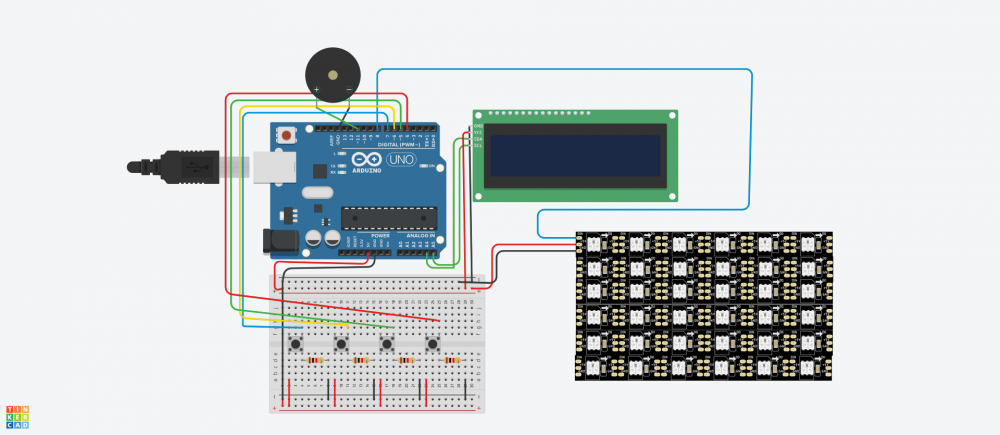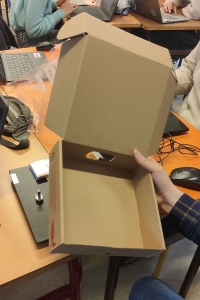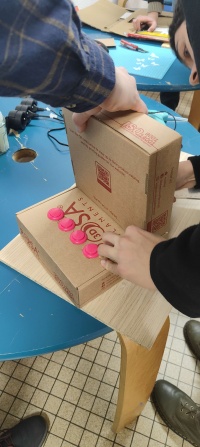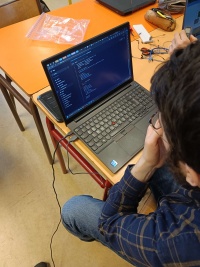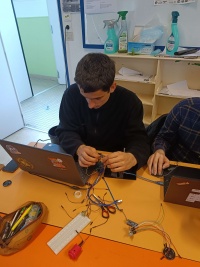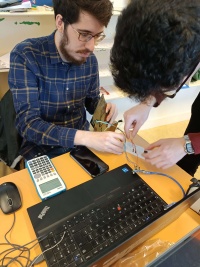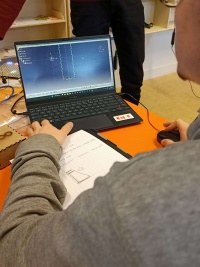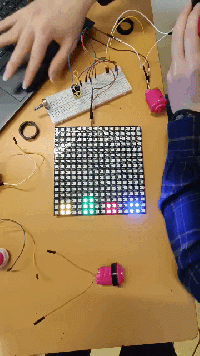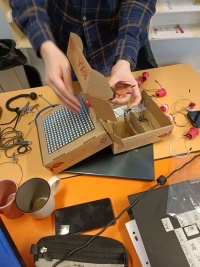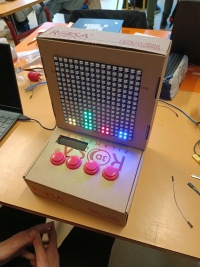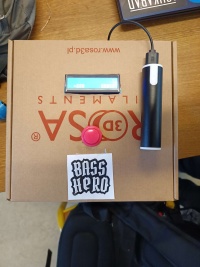ENIB 2024 : Bass Hero
Titre de la fiche expérience :
Sommaire
Description (résumé)
Notre équipe a décidé pour se Hackathon de créer un jeu de rythme inspiré de la série de jeux vidéos "Guitar Hero" qui consiste à appuyer sur des boutons en fonction du rythme de la musique et des indications à l'écran. Nous l'avons nommé "Bass Hero"
Pour ce faire des carrés lumineux descendront sur un écran LED 16x16 et indiqueront au joueur à quels moments appuyer sur les boutons correspondant
Introduction
Nous sommes 5 à participer à ce projet:
Yassine, Olivier, Antoine, Yann, Rodrigue
Le projet que nous avons choisis n'avait pas de thème précis donc nous avons pu laisser libre cours à notre imagination, et nous avons donc eu l'idée de faire un jeu de rythme simple pour pouvoir utiliser complétement la grille de LED 16x16 qui nous a été donné
Outil et matériel
- Carte Arduino Nano
- 4 Boutons
- Buzzer Piézo-électrique
- Câbles
- BreadBoard
- Écran LCD
- Écran LED 16x16
- Boite en carton
Fichiers joint
Code Arduino
<syntaxhighlight lang="Arduino" line>
- include <Adafruit_GFX.h>
- include <Adafruit_NeoMatrix.h>
- include <Adafruit_NeoPixel.h>
- define NOTE_B0 31
- define NOTE_C1 33
- define NOTE_CS1 35
- define NOTE_D1 37
- define NOTE_DS1 39
- define NOTE_E1 41
- define NOTE_F1 44
- define NOTE_FS1 46
- define NOTE_G1 49
- define NOTE_GS1 52
- define NOTE_A1 55
- define NOTE_AS1 58
- define NOTE_B1 62
- define NOTE_C2 65
- define NOTE_CS2 69
- define NOTE_D2 73
- define NOTE_DS2 78
- define NOTE_E2 82
- define NOTE_F2 87
- define NOTE_FS2 93
- define NOTE_G2 98
- define NOTE_GS2 104
- define NOTE_A2 110
- define NOTE_AS2 117
- define NOTE_B2 123
- define NOTE_C3 131
- define NOTE_CS3 139
- define NOTE_D3 147
- define NOTE_DS3 156
- define NOTE_E3 165
- define NOTE_F3 175
- define NOTE_FS3 185
- define NOTE_G3 196
- define NOTE_GS3 208
- define NOTE_A3 220
- define NOTE_AS3 233
- define NOTE_B3 247
- define NOTE_C4 262
- define NOTE_CS4 277
- define NOTE_D4 294
- define NOTE_DS4 311
- define NOTE_E4 330
- define NOTE_F4 349
- define NOTE_FS4 370
- define NOTE_G4 392
- define NOTE_GS4 415
- define NOTE_A4 440
- define NOTE_AS4 466
- define NOTE_B4 494
- define NOTE_C5 523
- define NOTE_CS5 554
- define NOTE_D5 587
- define NOTE_DS5 622
- define NOTE_E5 659
- define NOTE_F5 698
- define NOTE_FS5 740
- define NOTE_G5 784
- define NOTE_GS5 831
- define NOTE_A5 880
- define NOTE_AS5 932
- define NOTE_B5 988
- define NOTE_C6 1047
- define NOTE_CS6 1109
- define NOTE_D6 1175
- define NOTE_DS6 1245
- define NOTE_E6 1319
- define NOTE_F6 1397
- define NOTE_FS6 1480
- define NOTE_G6 1568
- define NOTE_GS6 1661
- define NOTE_A6 1760
- define NOTE_AS6 1865
- define NOTE_B6 1976
- define NOTE_C7 2093
- define NOTE_CS7 2217
- define NOTE_D7 2349
- define NOTE_DS7 2489
- define NOTE_E7 2637
- define NOTE_F7 2794
- define NOTE_FS7 2960
- define NOTE_G7 3136
- define NOTE_GS7 3322
- define NOTE_A7 3520
- define NOTE_AS7 3729
- define NOTE_B7 3951
- define NOTE_C8 4186
- define NOTE_CS8 4435
- define NOTE_D8 4699
- define NOTE_DS8 4978
- define REST 0
- define PIN 8
- define BTN_X 2
- define BTN_Y 3
- define BTN_Z 4
- define BTN_W 5
- ifndef PSTR
#define PSTR // Make Arduino Due happy
- endif
// change this to whichever pin you want to use int buzzer = 11;
int music[] = {1,0,3,0,0,2,3,1,1,2,3,1,1,0,2,1,3,1,0,3,0,0,2,3,1,1,2,3,1,1,0,2,1,3,1,0,3,0,0,2,3,1,1,2,3,1,1,
0,2,1,3,1,0,3,0,0,2,3,1,1,2,3,1,1,0,2,1,3,1,0,3,0,0,2,3,1,1,2,3,1,1,0,2,1,3,1,0,3,0,0,2,3,1,1,
0,2,1,3,1,0,3,0,0,2,3,1,1,2,3,1,1,0,2,1,3,1,0,3,0,0,2,3,1,1,2,3,1,1,0,2,1,3,1,0,3,0,0,2,3,1,1,
0,2,1,3,1,0,3,0,0,2,3,1,1,2,3,1,1,0,2,1,3,1,0,3,0,0,2,3,1,1,2,3,1,1,0,2,1,3,1,0,3,0,0,2,3,1,1,};
int tempo = 100; //int wholenote = (60000 * 4) / tempo;
// notes of the moledy followed by the duration. // a 4 means a quarter note, 8 an eighteenth , 16 sixteenth, so on // !!negative numbers are used to represent dotted notes, // so -4 means a dotted quarter note, that is, a quarter plus an eighteenth!! /*int melody[] = {
// Nokia Ringtone // Score available at https://musescore.com/user/29944637/scores/5266155 NOTE_E5, 8, NOTE_D5, 8, NOTE_FS4, 4, NOTE_GS4, 4, NOTE_CS5, 8, NOTE_B4, 8, NOTE_D4, 4, NOTE_E4, 4, NOTE_B4, 8, NOTE_A4, 8, NOTE_CS4, 4, NOTE_E4, 4, NOTE_A4, 2,
};*/ int melody[] = {
// Song of storms - The Legend of Zelda Ocarina of Time. // Score available at https://musescore.com/user/4957541/scores/1545401 NOTE_D4,4, NOTE_A4,4, NOTE_A4,4, REST,8, NOTE_E4,8, NOTE_B4,2, NOTE_F4,4, NOTE_C5,4, NOTE_C5,4, REST,8, NOTE_E4,8, NOTE_B4,2, NOTE_D4,4, NOTE_A4,4, NOTE_A4,4, REST,8, NOTE_E4,8, NOTE_B4,2, NOTE_F4,4, NOTE_C5,4, NOTE_C5,4, REST,8, NOTE_E4,8, NOTE_B4,2, NOTE_D4,8, NOTE_F4,8, NOTE_D5,2, NOTE_D4,8, NOTE_F4,8, NOTE_D5,2, NOTE_E5,-4, NOTE_F5,8, NOTE_E5,8, NOTE_E5,8, NOTE_E5,8, NOTE_C5,8, NOTE_A4,2, NOTE_A4,4, NOTE_D4,4, NOTE_F4,8, NOTE_G4,8, NOTE_A4,-2, NOTE_A4,4, NOTE_D4,4, NOTE_F4,8, NOTE_G4,8, NOTE_E4,-2, NOTE_D4,8, NOTE_F4,8, NOTE_D5,2, NOTE_D4,8, NOTE_F4,8, NOTE_D5,2,
NOTE_E5,-4, NOTE_F5,8, NOTE_E5,8, NOTE_E5,8, NOTE_E5,8, NOTE_C5,8, NOTE_A4,2, NOTE_A4,4, NOTE_D4,4, NOTE_F4,8, NOTE_G4,8, NOTE_A4,2, NOTE_A4,4, NOTE_D4,1,
};
// sizeof gives the number of bytes, each int value is composed of two bytes (16 bits) // there are two values per note (pitch and duration), so for each note there are four bytes int notes = sizeof(melody) / sizeof(melody[0]) / 2;
// this calculates the duration of a whole note in ms int wholenote = (60000 * 4) / tempo;
int divider = 0, noteDuration = 0;
Adafruit_NeoMatrix matrix = Adafruit_NeoMatrix(16, 16, PIN,
NEO_MATRIX_BOTTOM + NEO_MATRIX_RIGHT +
NEO_MATRIX_COLUMNS + NEO_MATRIX_ZIGZAG,
NEO_GRB + NEO_KHZ800);
const uint16_t colors[] = { matrix.Color(255, 184, 28), matrix.Color(0, 219, 73), matrix.Color(255, 41, 60), matrix.Color(24, 12, 255), matrix.Color(50, 50, 50) };
int score = 0; int pass = 0; int iterator = 0; int currentState = LOW;
void setup() {
// put your setup code here, to run once: matrix.begin(); matrix.setTextWrap(false); matrix.setBrightness(40); matrix.setTextColor(colors[0]);
pinMode(BTN_X, INPUT_PULLUP); pinMode(BTN_Y, INPUT_PULLUP); pinMode(BTN_Z, INPUT_PULLUP); pinMode(BTN_W, INPUT_PULLUP);
}
bool play_note(int offset, int color, int thisNote) {
bool note_played = false; int x=matrix.width(); int t_start=millis(); int t_loop=millis();
divider = melody[thisNote + 1];
if (divider > 0) {
// regular note, just proceed
noteDuration = (wholenote) / divider;
} else if (divider < 0) {
// dotted notes are represented with negative durations!!
noteDuration = (wholenote) / abs(divider);
noteDuration *= 1.5; // increases the duration in half for dotted notes
}
while (x>1) {
x=x-1;
matrix.begin();
matrix.drawLine(x, 1+offset, x-1, 1+offset, colors[color]);
matrix.drawLine(x, 2+offset, x-1, 2+offset, colors[color]);
matrix.drawLine(x+1, 1+offset, x+1, 2+offset, matrix.Color(0, 0, 0));
matrix.show();
while (1) {
t_loop=millis();
if (x<10) {
/* IMPLEMENT BUTTON CHECK */
/* PLAY NOTE SOUND HERE ? */
currentState=HIGH;
if (color==0) {currentState = digitalRead(BTN_X);}
else if (color==1) {currentState = digitalRead(BTN_Y);}
else if (color==2) {currentState = digitalRead(BTN_Z);}
else if (color==3) {currentState = digitalRead(BTN_W);}
if (currentState!=HIGH) {
note_played=true;
}
if (note_played==true) {
tone(buzzer, melody[thisNote], noteDuration * 0.9);
}
}
if (t_loop>t_start+15) {
t_start=millis();
noTone(buzzer);
break;
}
}
}
return note_played;
}
void loop() {
if (play_note(4*music[iterator], music[iterator], iterator*2)==true) {score+=1;}
else {/* DO SOMETHING IF MISSED NOTE */}
++iterator; if (iterator>(int)(sizeof(melody)/2)) {iterator=0;}
//delay(100);
}
Étapes de fabrication
Voici les différentes étapes que nous avons utilisé pour arriver au projet final:
Étape 1
Pour commencer on a fabriqué un prototype de la boite en partant d'un carton vide, qui contiendra les circuits internes pour avoir une idée de à quoi ressemblera le projet final:
Étape 2
Début de la création du code (connexions à la carte, affichage des lumières):
Étape 3
Préparation des circuits électroniques:
Étape 4
Préparation de la boite du produit final:
Étape 5
Finalisation du code et préparation des interactions avec le joueur:
Étape 6
Installation des composants:
Étape 7
Projet Terminé:
Difficultés rencontrés
Le plus gros problème qui nous a été posé été la presque impossibilité de se connecter à la carte ESP32 et à la carte Arduino qui avait été utilisé pour replacer la carte ESP32 à cause de ce problème. Cette difficulté est celle qui nous a fait perdre la grande majorité de notre temps et qui a dû être compenser par la programmation du jeu en dehors des heures allouées. Nous n'avons pas vraiment réglé ce souci mais nous avons dû faire avec.
Nous n'avons pas pu utiliser la boite du prototype car nous n'avons pas eu le temps de découper les planches de bois bien que les plans soient prêt à être utilisés et des composants été cassés
Nous avons aussi dû abandonner l'idée d'utiliser des haut parleurs pour la musique et le remplacer par un buzzer piézo-électrique de plus l'installation du lecteur LCD n'a pas pu être faites par manque de temps
Projet Complémentaire Bass Hero +
En vue de la possibilité de non réussite du projet Bass Hero, nous avons pu faire en une dizaine de minutes et en nous basant sur les connaissances acquises pendant ce Hackaton, un autre jeu pour pouvoir présenter quelque chose aux enfants.
Ce jeu ce base sur le très célèbre "Dinosaur game" qui apparait quand un utilisateur du navigateur Google n'a pas de connexion.
Bass Hero + ce joue en appuyant sur le bouton central pour pouvoir esquiver les obstacles barrant la route du joueur.






